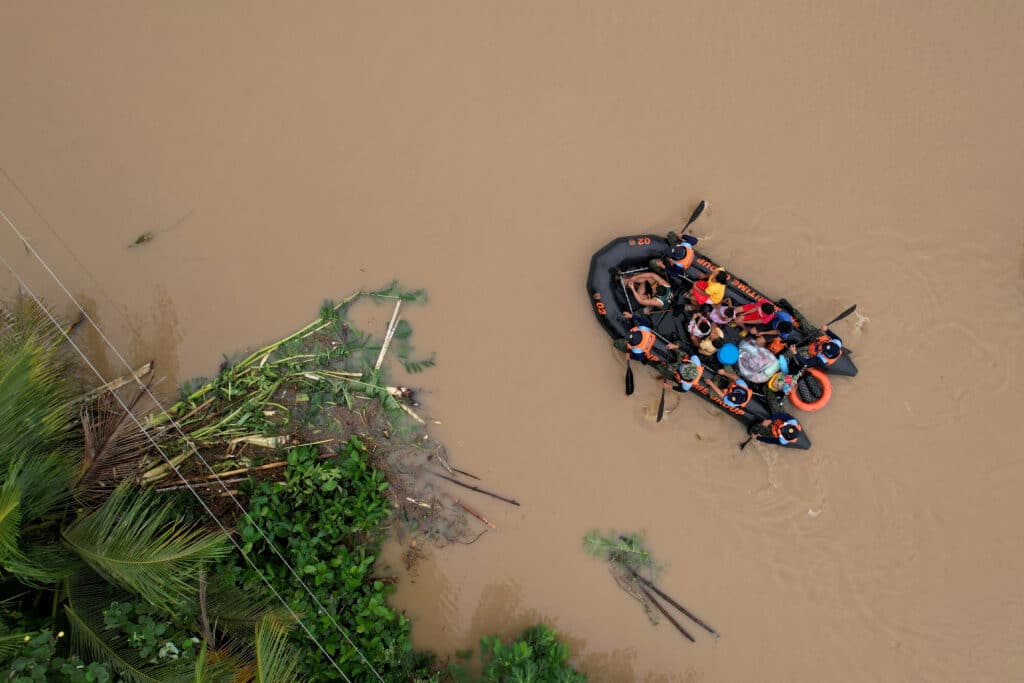
An aerial view shows a coast guard rescue boat evacuating residents to safer gounds in Polangui town, Albay province South of Manila on October 23, 2024. | Photo by CHARISM SAYAT / AFP
MANILA, Philippines — Rescuers waded through chest-deep floodwaters on Wednesday, October 23, to reach residents trapped by Severe Tropical Storm Kristine (International name: Trami), which has killed 14 people and forced thousands to evacuate as it barrels toward the east coast of the Philippines.
Torrential rain has turned streets into rivers, submerged entire villages and buried some vehicles in volcanic sediment set loose by the downpour.
READ MORE:
Kristine makes landfall; Intense rains expected in 9 provinces
Kristine: Severe tropical storm to make landfall over Isabela
At least 32,000 people have fled their homes in the northern Philippines, police said, as the storm edges closer to the Southeast Asian country’s main island of Luzon.
This handout photo taken and released on October 23, 2024 by the Philippine Coast Guard (PCG) shows residents affected by Tropical Storm Trami being evacuated from the roofs of their submerged houses, in Libon town, Albay province, South of Manila. | Photo by Handout / Philippine Coast Guard (PCG) / AFP
In the Bicol region, about 400 kilometres (249 miles) southeast of the capital Manila, “unexpectedly high” flooding was complicating rescue efforts, said police.
“We sent police rescue teams but they struggled to enter some areas because the flooding was high and the current was so strong,” regional police spokeswoman Luisa Calubaquib told AFP.
Eleven people drowned in floodwaters in the Bicol city of Naga, local police chief Erwin Rebellion told AFP.
An elderly woman drowned in Quezon province southeast of the capital, while a toddler was also killed after falling into a flooded canal, police said.
Manila’s civil defence office reported one person was killed by a falling tree branch.
This handout photo taken and released on October 23, 2024 by the Philippine Coast Guard (PCG) shows residents affected by Tropical Storm Trami standing on the roofs of their submerged houses before being evacuated, in Libon town, Albay province, South of Manila. | Photo by Handout / Philippine Coast Guard (PCG) / AFP
Kristine makes landfall
The Philippine Atmospheric Geophysical Astronomical Services Administration (Pagasa), state weather bureau, said in its 2 a.m., Thursday, October 24, advisory, that Severe Tropical Storm Kristine has made landfall in Divilacan town in Isabela province at 12:30 a.m. on Thursday, October 24.
The state weather bureau in the advisory said that the storm’s center was in the victinity of Bicobian, Divilacan town.
In its 8 p.m. Wednesday, October 23, advisory, Pagasa said that Kristine was expected to smash into the coast of Isabela sometime during the night or early Thursday morning, slightly weakening as it crosses the island and heads out into the South China Sea.
Meanwhile, more than 500 millimetres (1.64 feet) of rain, or over a month’s worth, has already fallen on the region in the past 24 hours.
A handout photo from the facebook page of Ree Tabagan taken on October 23, 2024, shows flooded roads due to tropical storm Trami in Bato, Camarines Sur. | Photo by Ree Tabagan / facebook page of Ree Tabagan / AFP
Photos verified by AFP on Wednesday showed streets submerged by muddy floodwaters in Camarines Sur province’s Bato municipality, with only the roofs of houses and convenience stores visible.
“It’s getting dangerous. We’re waiting for rescuers,” resident Karen Tabagan told AFP.
’Feeling a little helpless’
In Naga, about 40 kilometres from Bato, half of the 600 villages were fully submerged by flooding.
‘Worst has yet to come’
At an emergency meeting of government agencies Wednesday morning, President Ferdinand Marcos said that “the worst is yet to come”.
“I’m feeling a little helpless here because… all we can do is sit tight, wait, hope and pray that there is not too much damage, that there are no casualties.”
Families driven from their homes in Bicol were being sheltered at about 2,500 various evacuation centres.
An aerial shot of vehicles buried by volcanic ash from nearby Mayon volcano which cascaded into a village triggered by heavy rains brought about by Tropical Storm Trami at a village in Guinobatan town, Albay province South of Manila on October 23, 2024. | Photo by Charism SAYAT / AFP
Volcanic sediment was also unleashed by the rain from the Philippines’ famous Mayon volcano, according to Calubaquib, the Bicol police spokeswoman.
Pre-emptive evacuations in Isabela
Further north in Isabela province, authorities evacuated 216 people from the coast near Divilacan and another 60 from nearby Palanan municipality after the weather service warned of “moderate to significant risk of life-threatening storm surge” or high coastal waves.
“They had to conduct pre-emptive evacuations in response to the storm surge warning … They had to evacuate some Indigenous people who are living in houses made of light materials,” Isabela provincial disaster official Constante Foronda told AFP.
Residents look at a car buried by volcanic ash which cascaded into a village triggered by heavy rains brought about by Tropical Storm Trami at a village in Guinobatan town, Albay province South of Manila on October 23, 2024. | Photo by Charism SAYAT / AFP
Storms and typhoons are common around the region at this time of year.
However, a recent study showed that they are increasingly forming closer to coastlines, intensifying more rapidly and lasting longer over land due to climate change.
About 20 big storms and typhoons hit the Philippines or its surrounding waters each year, damaging homes and infrastructure and killing dozens of people.